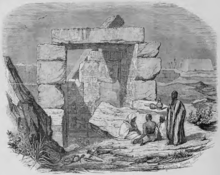| Karnak King List | |
|---|---|
 Drawing of the list in 1843 | |
| Created | c. 1450 BC |
| Discovered | before 1826 Luxor, Luxor Governorate, Egypt |
| Present location | Paris, Ile-de-France, France |
The Karnak King List, a list of early Egyptian kings engraved in stone, was located in the southwest corner of the Festival Hall of Thutmose III, in the middle of the Precinct of Amun-Re, in the Karnak Temple Complex, in modern Luxor, Egypt. Composed during the reign of Thutmose III, it listed sixty-one kings beginning with Sneferu from Egypt's Old Kingdom. Only the names of thirty-nine kings are still legible, and one is not written in a cartouche (a border used normally to surround the name of a king).
It is not a complete list of the Egyptian pharaohs, as other kings are known from other ancient lists, but this list is valuable as it contains the names of kings of the First and Second Intermediate Periods, which are omitted in most other king lists.
It was first described by James Burton in 1825.[1] In 1843, a German expedition directed by Egyptologist Karl Lepsius was traveling up the Nile River to Karnak. A French adventurer, Émile d'Avennes, dismantled and stole the blocks containing the king list one night in order to secure it for France, and sent it home.[2][3] Severely damaged, it is now on display at the Louvre[4] in Paris.
- ^ Burton, James: "Excerpta Hieroglypica", Plate Ia, Cairo, 1825
- ^ "L'Illustration, Journal Universel", Vol. VII, p 244-245, Paris 1846
- ^ Monderson, Frederick. "Temple of Karnak: The Majestic Architecture of Ancient Kemet" p. 58
- ^ Chapelle des ancêtres in the Sully wing, Rez-de-chaussée, Room 12, Catalogue number E13481bis